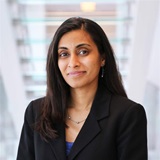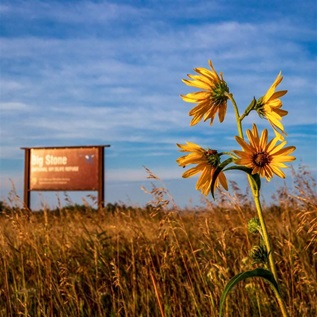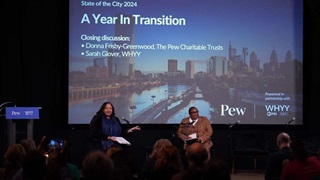To Protect its Valuable Seagrass, Seychelles Leverages Partnerships
Local advocacy group leads efforts to protect ecosystem that stores carbon, helps marine life, and supports communities

It’s safe to say most people don’t spend a lot of time contemplating seagrass. But if they knew its remarkable value to nature, coastal communities, and economies, perhaps they would. Seagrass provides habitat and nursery grounds for marine life and helps communities become more resilient to a changing climate by buffering storm surges and filtering water.
Further, scientists estimate that coastal wetlands—which include seagrasses, mangroves, and saltmarshes—can sequester and store up to five times more carbon per hectare than terrestrial forests.
To harness this full range of benefits to climate, people, and nature, the government of Seychelles pledged to protect 100% of its seagrass meadows by 2030 within its commitments—known as the country’s Nationally Determined Contribution (NDC)—to achieving the goals of the Paris Agreement, the landmark international climate change treaty that came out of the 2015 United Nations Climate Change Conference.
The archipelago of 115 islands in the Indian Ocean off the east coast of Africa is the first nation in the world to create a field-validated map for seagrass meadows across its waters and to estimate how much carbon those seagrasses store.
To assist this effort, The Pew Charitable Trusts supported research—the Seagrass Mapping and Carbon Assessment Project—led by the University of Oxford in partnership with two local nongovernmental organizations, Seychelles Conservation and Climate Adaptation Trust (SeyCCAT) and Island Conservation Society; the University of Seychelles; the German Aerospace Agency; and others.
SeyCCAT CEO Marie-May Jeremie and Coastal Wetlands and Climate Change Project Manager Annike Faure have both been instrumental in Seychelles’ efforts to raise public awareness about the benefits of seagrass and the importance of conserving these vital ecosystems.
This interview with them has been edited for length and clarity.
The government of Seychelles has put itself at the forefront of ocean protections by being one of the first countries to commit to protect 30% of its waters. Tell us why.
Jeremie: The answer is simple: We are 99% ocean, so oceans really define our identity as a nation. We have also in recent years started to feel the impacts of climate change on our receding coastlines and we therefore understand that protection of our ocean is essential.
Faure: Tourism is one of our main economic pillars, and tourists come for our islands and beautiful beaches. Seychellois also love going to the beach on the weekends and enjoying the marine hues of blues and greens of the sea. Seagrass provides many ecosystem services that are vital for Seychelles and our culture—supporting commercial fisheries such as kordonyen or rabbitfish; local fisher
Jeremie: So our commitments to date have arisen out of necessity. Looking ahead as we transition to implementation of the Seychelles Marine Spatial Plan Initiative—a government-led process focused on planning for the sustainable use and health of the ocean—and management of the 30% marine protection areas, our efforts are focused on effective management that’s informed by science, supported by lasting partnerships, and steered by committed leadership.
Can you tell us what the Seychelles Seagrass Mapping and Carbon Assessment is?
Jeremie: Sure. It was a highly collaborative project led by the University of Oxford, in partnership with our organization, the University of Seychelles, the German Aerospace Agency, another local nongovernmental organization known as the Island Conservation Society, and supported by The Pew Charitable Trusts.
The idea was to create a field-validated map for seagrass meadows in Seychelles and to try to figure out how much carbon these seagrasses store. Before this project, the country’s seagrass map was created from satellite images, which only gave a general baseline estimate of meadow coverage. But with this new map, which includes field verification, managers can better distinguish between seagrass meadows and areas that might be predominantly algae.
And now that you have the information, what will you do with it?
Jeremie: This information from the seagrass mapping project should lead to improved management of seagrass ecosystems. The research will now be used to inform a blue carbon policy that will contribute toward sustainable blue carbon ecosystem management and provide continuous education and involvement of local stakeholders and the public.
Why is this protection project so significant?
Jeremie: Seychelles is a small island developing state, and we’re mindful of our vulnerabilities to climate change, so it was really no surprise that the government took such bold commitments in its Nationally Determined Contribution as part of the Paris Agreement. Seychelles wanted for the first time to include our blue carbon ecosystems in our national greenhouse gas inventory, and we knew that the extent of our blue carbon habitats—seagrass and mangroves—would play a significant role in both our mitigation and adaptation goals. We were also mindful, when identifying areas for protection under the Seychelles Marine Spatial Plan Initiative, that this work would fit in well with our commitment to protect 30% of our exclusive economic zone.
Why is the science component so critical to policymaking?
Jeremie: We wanted to have a documented methodology that will be replicable and scalable within and beyond Seychelles. We also wanted robust science to inform the development of the NDC and national policies for management of these critical habitats. For a long time, there have been assumptions about the extent and status of our seagrass meadows. Through this project we were able to determine whether these assumptions were true and give a level of confidence to areas that were assumed to be seagrass.
For instance, through the Seychelles Marine Spatial Plan Initiative, we had proposed protection of areas where we assumed seagrasses existed. The scientific data that we collected and collated during the project enabled us to confirm some of areas, and the data will also now form the baseline for the country and will be crucial in protecting and managing seagrass.
Tell us more about partnerships across this project.
Jeremie: The partnerships help us strengthen local research capacity, for one—and partnerships and capacity building are key to the success of any project in the Seychelles. We saw this project as a first step in what will become a long-term monitoring and management program for Seychelles seagrass. And with seagrass mapping being so new, we wanted to ensure that we attracted the right expertise through partners such as Pew and Oxford University, so we could in turn share those experiences with local research partners, such as the University of Seychelles’ Blue Economy Research Institute, and management partners, such as Island Conservation Society. Local capacity will help us replicate the mapping exercise in the Seychelles and, more importantly, throughout the region.
Your organization, SeyCCAT, led a robust public awareness campaign in support of the country’s climate commitment—with one major outcome being the development of words in Seychellois Creole for “seagrass.” Why was that important?
Faure: Creole is one of three official languages in Seychelles, the others being French and English. Developing words for seagrass in our native language couldn’t be done as a stagnant, bureaucratic, top-down approach. Rather, we wanted to ensure that the public was consulted and included in this process. And having the public involved from the beginning ensured that the words approved by the Seychelles Creole Academy—an organization within the Seychelles National Institute for Culture, Heritage, and the Arts—would stay in everyone’s vocabulary, and be included in the updated Creole dictionary.
So how did that work, in terms of getting the public involved?
Faure: The project team used social media and media organizations, including newspapers and radio spots, to ask the public to help name seagrasses. We also consulted with local fishermen in various districts in the inner islands of Mahé, Praslin, and La Digue, and with linguistic experts, marine biologists, and fisheries scientists in the islands and regionally. We wanted to ensure that we knew what names were already being used, and also to figure out if some seagrass lifeforms didn’t have names yet and therefore needed them.
And what was the result?
Faure: We are proud to have facilitated the conversation with the community that led to the creation of locally derived Creole words for seagrass, “zerb lanmer” and “gomon zerb,” as well as names for five groups of seagrass lifeforms, which are species with similar characteristics.
There was also a specific youth component to your public campaign around coming up with Creole words. How did that work?
Faure: The Creole names for seagrasses were presented in the curriculum of two different University of Seychelles courses taught by Dr. Jeanne A. Mortimer. Less formal workshops were also conducted for primary- and secondary-level students of the Wildlife Clubs and the Museum Club. These were more interactive, where we collected seagrass and seaweed from the beaches. Dr. Mortimer made a presentation to the children, where we introduced the proposed names and got their feedback. And then they got to dig in specimen “salads” with magnifying glasses to see if they could identify the seagrass types. Once that was done, they received an activity book called The Wonders of Gomon Lanmer. We hope to continue with such trainings in the future.
SeyCCAT launched a comprehensive grassroots campaign to raise awareness of the value of seagrass as an important blue carbon ecosystem in Seychelles. This video showcases the breadth of that project.
A new Pew-led project to map seagrass across the Western Indian Ocean will begin soon. Based on your experiences, what advice would you have for people in other countries, both in the region and elsewhere?
Jeremie: Within the Western Indian Ocean, there is a strong potential for countries to work together, and Seychelles is of course willing and committed to ensure transfer of learnings and experiences. One of our key takeaways is to promote the critical importance that blue carbon habitats play in maintaining the integrity of our coasts and oceans, so we can justify the need to protect them. This should be the guiding principle in this work. Secondly is the potential that partnerships can play in undertaking such work; through partnerships, Seychelles has developed a tried and tested methodology that can be adapted and scaled. Furthermore, it is important to ensure capacity building to empower locals to have full ownership of the process within their countries.
Faure: It takes a lot of work—a lot of teamwork—with a lot of moving pieces so sometimes you wonder how it’s going to fit and what picture it will give at the end. Patience is key, because mapping seagrass through partnerships is an emerging technique in the world—so its application in every region, even on a microscale, may be different. The region will invest a lot of time and energy toward creating the map and other products, which will help advance the science on seagrass and support Seychelles in its commitment to protect seagrass.
This video is hosted by YouTube. In order to view it, you must consent to the use of “Marketing Cookies” by updating your preferences in the Cookie Settings link below. View on YouTube
This video is hosted by YouTube. In order to view it, you must consent to the use of “Marketing Cookies” by updating your preferences in the Cookie Settings link below. View on YouTube


Seychelles' 'Grass-Roots' Effort Supports Conservation Effort


Seychelles Seagrass Research Supports Climate Commitments


Pew Applauds Seychelles Pioneering Plan to Protect Seagrass
Spotlight on Mental Health
MORE FROM PEW
Explore Pew’s new and improved
Fiscal 50 interactive
Your state's stats are more accessible than ever with our new and improved Fiscal 50 interactive:
- Maps, trends, and customizable charts
- 50-state rankings
- Analysis of what it all means
- Shareable graphics and downloadable data
- Proven fiscal policy strategies
Welcome to the new Fiscal 50
Key changes include:
- State pages that help you keep track of trends in your home state and provide national and regional context.
- Interactive indicator pages with highly customizable and shareable data visualizations.
- A Budget Threads feature that offers Pew’s read on the latest state fiscal news.














